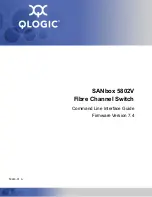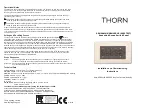
DigitalEQ
TM
Receiver Hub Product Installation
Manual Models NV-872, NV-1672 and NV-3272
The Digital EQ
TM
Receiver Hub is an active (ampli-
fied) hub that allows the transmission of real-time
monochrome or color video for distances up to one
mile (1,6km) using Category-rated Unshielded
Twisted-Pair (UTP) wire. Note: PAL video does require
the use of Category-5 or better at 1 mile (1,6km). The
receiver hub continuously and automatically compen-
sates for cable attenuation, ground-loops, and wiring
polarity, independent of the video signal image. The
1U high hub is equipped with multi-stage transient
protection.
The NV-872 is an 8-port receiver with four DA out-
puts per channel. The NV-1672 is a 16-port receiver
with two DA outputs per channel. The NV-3272 is a
32-port receiver with one output per channel.
Wire Type
The DigitalEQ
TM
UTP Receiver Hub operates best with
category-rated Unshielded twisted-pair (UTP) wire. It
may also be used with category-rated foiled twisted-
pair (FTP) wire, or with multi-pair wire with an overall
shield (6 or more pairs). Wire gauges of 24 to 16 AWG
(0,5 to 1,3mm) are supported.
Shielded twisted-pair (STP) wire may also be used,
up to a maximum distance of 1,000ft (300m).
The video signal may co-exist in the same wire
bundle as other video, telephone, data, control signals,
or low-voltage power. It is also OK to run NVT signals
near electromagnetic fields (in accordance with
National Electrical Code, and other local safety
requirements.
Do NOT use un-twisted wire. Due to near-end
crosstalk, do not send a transmit and a receive signal
in the same wire bundle. Exception: Up to 1,000ft
(300m); or 2,000ft (600m) Category 5 or better.
Up-the-Coax Pan/Tilt/Zoom telemetry signals are
NOT supported. Use a second wire-pair for RS-422 or
RS- 485 signals instead.
NVT recommends the use of factory-crimped RJ45
patch cables rather than unreliable field-crimped RJ45s
to connect between the NVT deviceand an adjacent
female RJ45 jack.
Wire Distance
It is recommended that the wire distance be measured
to ensure that it does not exceed 3,000ft (1km), or
1 mile 5,280ft (1,6km) if the transmitter is an NV-653T.
Recommended Wire Distance
:
All measured distances include any coax in the path.
Wire resistance may be measured with an ohm-meter
by shorting the two conductors together at the far end,
and measuring the loop-resistance out and back.
Loop Resistance per 1,000ft (300m)
24 AWG (0,53 mm)
=
52 ohms
23 AWG (0,57 mm)
=
42 ohms
22 AWG (0,64 mm)
=
33 ohms
20 AWG (0,81 mm)
=
21 ohms
19 AWG (0,91 mm)
=
16 ohms
18 AWG (1,02 mm)
=
13 ohms
Wire in underground conduit or wet locations must be
polyethylene-jacketed, gel-filled. Wire in plenum envi-
ronments must be plenum-rated, per local codes.
Connecting the Camera End
Use any NVT passive transceiver, (such as the
NV-214A-M) or qualified OEM camera with built-in UTP
output, or the NV-653T Active Transmitter. Install per the
instructions that come with the transmitting device.
1) Read these instructions.
2) Keep these instructions.
3) Heed all warnings.
4) Follow all instructions.
5) Do not use this apparatus near water.
6) Clean only with a dry cloth.
7) Do not block any ventilation openings.
8) Install in accordance with the manufacturer’s instructions.
9) Do not install near any heat sources such as radiators,
heat registers, stoves or other apparatus (including DVRs)
that produce heat.
10) Do not defeat the safety purpose of the polarized or
grounding-type plug. A polarized plug has two blades with
one wider than the other. A grounding type plug has two
blades and a third grounding prong. The wider blade or the
third prong are provided for your safety. If the provided plug
does not fit into your outlet, consult an electrician for replace-
ment of the obsolete outlet.
11) Protect the power cord from being walked on or pinched
particularly at plugs, convenience receptacles, and the point
where they exit from the apparatus.
12) Only use attachments/accessories specified by the
manufacturer.
13) Use only with cart, stand, tripod, bracket, or table spec-
ified by the manufacturer, or sold with the apparatus. When
a cart is used, use caution when moving the cart/apparatus
combination to avoid injury from tipover.
14) Unplug this apparatus during lightning storms or when
unused for long periods of time.
15) Refer all servicing to qualified service personnel. Servic-
ing is required when the apparatus has been damaged in any
way, such as a power supply cord or plug is damaged, liquid
has been spilled, or objects have fallen into the apparatus,
the apparatus has been exposed to rain or moisture, does
not operate normally, or has been dropped.
This installation should be made by a qualified
service person and should conform to all local codes.
WARNING - Do not install the unit in an environ-
ment where the operating ambient temperature exceeds
1220° F (50° C). The ventilation should not be impeded
by covering the ventilation openings with items, such as
newspapers, table-cloths, curtains, etc. No naked flame
sources, such as lighted candles should be placed on
the apparatus.
IMPORTANT SAFETY INSTRUCTIONS
TO REDUCE THE RISK OF ELECTRICAL SHOCK,
DO NOT REMOVE COVER OR BACK. NO USER
SERVICEABLE PARTS INSIDE. REFER SERVICING
TO QUALIFIED SERVICE PERSONNEL.
WARNING: TO REDUCE THE RISK OF ELECTRI-
CAL SHOCK, DO NOT EXPOSE THIS APPARATUS
TO RAIN OR MOISTURE.
WARNING - Do not interconnect multiple
outputs.
WARNING - The apparatus shall not be exposed
to dripping or splashing and no objects filled with
liquids, such as vases, shall be placed on the
apparatus.
WARNING - Use only a Certified power cord and
plug (coupler / mains) assemblies for location
installed.
WARNING - Power cord is regarded as main
disconnect.
WARNING - The appliance coupler (power
cord/mains) shall remain readily operable.
WARNING - For safety, never put NVT signals in
the same conduit as high-voltage wiring.
WARNING - Do not restrict airflow around any
active powered NVT products.
Cat 5 Wire Distance
Cat 5 Wire Distance
235
315
400
475
550
630
700
780
3 MHz
4 MHz
5 MHz
6 MHz
9 MHz
8 MHz
7 MHz
10 MHz
1
0
0
ft
C
a
m
e
ra
L
in
e
s
o
f R
e
so
lu
tio
n
F
re
q
u
e
n
c
y
3
0
0
ft
1
,0
0
0
ft
1
m
ile
3
,0
0
0
ft
1
0
,0
0
0
ft
3
0
m
1
0
0
m
3
0
0
m
1
,6
km
1
km
3
km
M
ax
P
as
s
iv
e
D
is
ta
n
c
e
M
ax
S
tu
b
E
Q
D
is
ta
n
c
e
M
a
x
D
ig
ita
lE
Q
D
is
ta
n
c
e




















